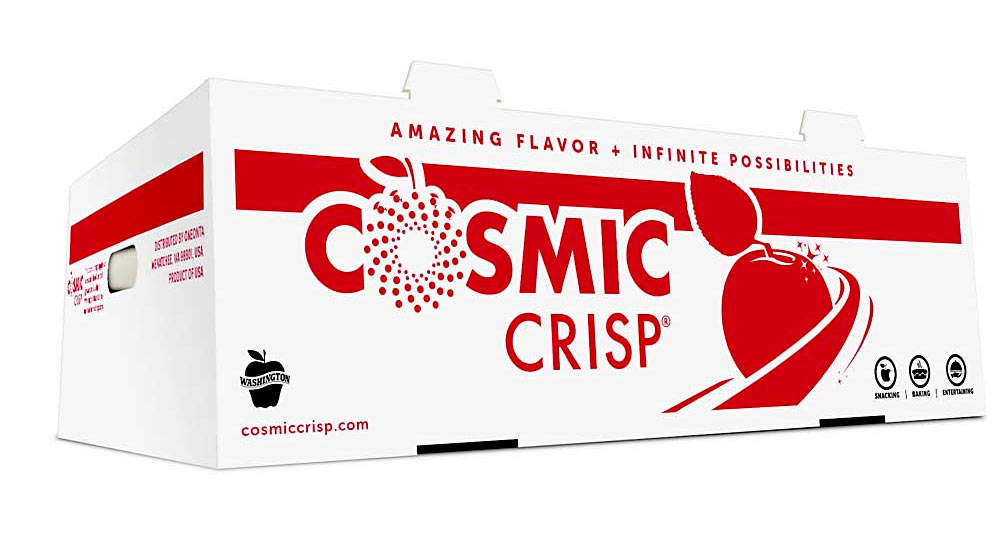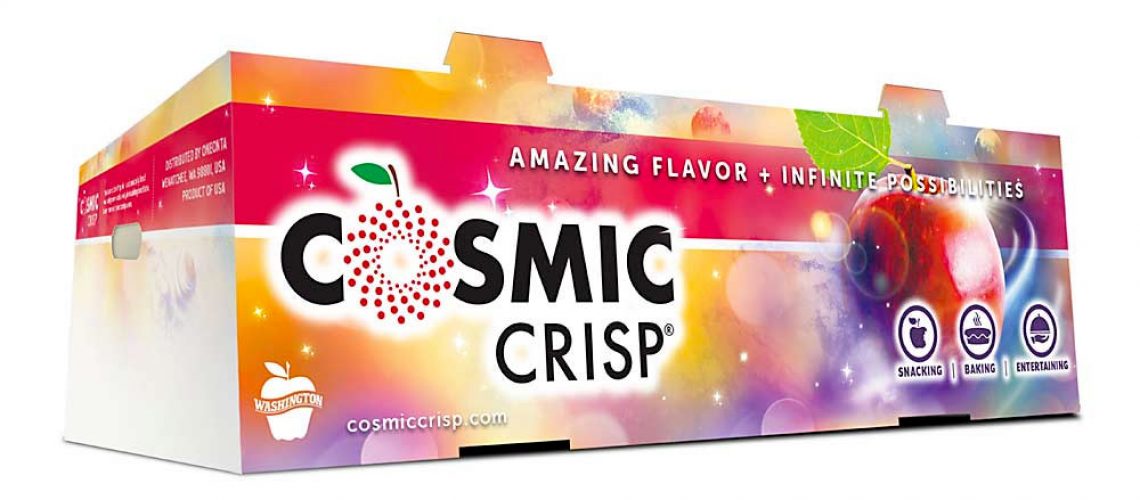Industry committee sets grade standards for new WSU-bred apple variety slated for commercial release this year.
– Shannon Dininny – Good Fruit Grower
A five-member committee composed of Washington growers, packers and sales house workers has settled on grading standards for the commercial release of WA 38, the new Washington State University-bred apple to be sold under the brand name Cosmic Crisp.
The group has been meeting since 2016 to establish grading and packing standards for the new variety in advance of its first commercial release, slated for later this year. The resulting standards stem in part from WSU and Washington Tree Fruit Research Commission studies into such things as color development, starch and dry matter.
“The group tried to keep the standards not too overbearing,” said Jill Burbery, marketing manager for Proprietary Variety Management, the company contracted by WSU to manage the variety and its commercial rollout.
“We wanted to give some guidelines so that everyone is on the same page. It’s a proprietary apple packed across the state on different lines, which makes it different from a proprietary apple that (a grower or packer) might have complete control over.”
With that said, Burbery stressed that the standards constitute a “living document” that will change with time and experience. “We don’t want anyone to feel this is decided and this is it,” she said. “We realize, as lucky as we are to have all this research from the university, we still know that once it’s available commercially, we will see things and we’ll learn from a commercial grow, and we’ll need to account for that in the future.”
Key aspects of the grading standards:
—Fruit from third-leaf trees can be sold beginning Dec. 1.
—Fruit from second-leaf trees can be sold no earlier than Jan. 1, 2020.
—Fruit should not be harvested at less than 2.5 on the starch scale and, in coordination with release dates, must reach a minimum of 5 on the starch scale to qualify for shipment to the fresh market. Meanwhile, the Washington Tree Fruit Research Commission is working to develop a starch scale specifically for Cosmic Crisp.
—The Cosmic Crisp grading scale for defects will adhere to the Washington Administrative Code (WAC), as administered by the Washington State Department of Agriculture and U.S. Department of Agriculture, for striped or partial red varieties.
—Fruit with 50 percent to full red color, free of defects, can be sold at extra fancy grade. Fruit with 30 percent and greater red color, with defects as allowed by state code, can be sold at fancy grade but will be confined to bulk products initially. Bulk products will be sold in two-color, 40-pound tray packs or Euro cartons only.
Individual packing facilities may choose to further segment extra fancy-grade fruit for specific customers if they choose, Burbery said.

PVM and WSU have not elected to seek a private grade for the variety, which would require approval from the state Legislature. “We’re not focusing on that right now,” Burbery said. “We are focused on getting it out there in a good consistent package and putting our best foot forward for the launch.”
Researchers are still wrapping up studies into the best methods to handle and store the fruit postharvest. Overall recommendations for those practices will come at a later date.
Looking ahead
Proper handling of the fruit will be crucial to a successful rollout — one that has huge ramifications for Washington’s apple industry, given the sizeable investment. Growers planted 632,000 trees in 2017 and more than 6 million trees last year, with a projected 5 million to be planted this year, according to PVM President Lynnell Brandt.
Working with WSU tree fruit breeder Kate Evans, PVM has developed production models for trees by maturity level, based on an 85 percent packout and 3 percent attrition rate on trees. The production estimate for 2019 is 467,000 boxes overall — 287,000 boxes from second-leaf trees, and 180,000 from third-leaf.
As expected, the production models increase dramatically in future years, to over 2 million boxes in 2020 and 5.6 million boxes in 2021.
“These are models. They can’t account for every nuance, but it does give us a fairly good picture,” Brandt said.
PVM projected that another 2 million trees would be planted in 2020, but that number may have been too conservative given the $10.5 million marketing campaign launched last fall for the variety, he said.
“Our rationale at the time we set the projection, which is typical, is that we would have a ramp-up and then people would want to see how it’s performing. There’s a wait-and-see attitude,” he said. The promotional effort may mean even more interest — heightened consumer interest begets retailer interest, retailer interest begets packer interest, and so on.
“As we have additional pressure on commodity selections to return a cost of production, people are anxious to know what to go to,” he said. “This launch, we think, is going to capture everybody’s attention.” •


